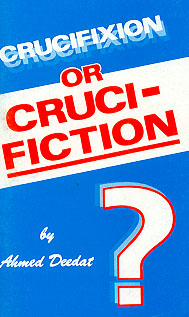Crucifixion Or Cruci-Fiction

CHAPTER 7
METHODS
OF CRUCIFIXION
ORIGINS OF CRUCIFIXION
Crucifixion was the common mode of eliminating political prisoners,
murderers and insurgents. Long before the birth of Jesus, the
Phoenecians had experimented with various methods to get rid of their
anti-social characters. They had tried hanging, impaling, stoning,
drowning, etc. But all these were too quick in their effects; the
culprits expired too soon for their liking. So they invented the
crucifixion, a system which produced a slow L-I-N-G-E-R-I-N-G death.
TWO METHODS OF CRUCIFIXION
The Romans borrowed and perfected the
system. They developed a crucifixion for fast death and disposal, and
another for a slow death and disposal.
The Christian Masters1 are
confused in their paintings of the gruesome scene. They portray the two
robbers2 who were simultaneously crucified
with Jesus, his "crossmates", one on his right hand and the other on
his left hand, as undergoing the FAST method, whereas Jesus himself is
painted as undergoing a S-L-O-W process.
The Romans never combined these two
different methods. They were never confused, as the Christian artists
were, with the fast and the slow methods. The Old Masters have painted
hybrid crosses (mixture) of the "fast" and "slow" methods in their
drawings of Jesus' bodily supports on the cross — i.e. with Sadile or
without sadile 3 either nails or leather thongs to
bind the arms to the crossbar; and, either platforms to support the
feet, or spikes.
1. Meaning great artists like Michaelangelo, Rembrandt,
Leonardo Da Vinci, etc.
2. Mark 15:27 - "lestes" in the original. Alternatively
translated as "thieves" or "brigandas" is actually a
derogatory term for "Zealot." These "crossmates" of Jesus were
not common thieves or crooks. They were the terrorists of their day,
heroes of their nation.
3. Sadile: Obviously a SADDLE, or "horn" which was
fitted in the middle of the upright piece of the cross, so that it
projected between victim's legs at the crotch to support his
body-weight, but for aesthetic reasons the Christian fathers have
eliminated the "horn" from the cross. See illustrations further down.
"THE GOSPEL UNTRUTH"
Contrary to common belief, Jesus was
not nailed to the cross, but bound, if at all, like the other two. In
the light of the knowledge available, we must regard the "Doubting
Thomas" episode as a flagrant "gospel fabrication", similar to the
story of the woman caught in the act of adultery. See below for a
reproduction of the Bible page and note that John chapter 8, begins
with verse 12. Can you imagine any chapter in any religious Book
beginning with verse 12 as the first verse? Verses 1 to 11 are expunged
as a fabrication by the 32 Christian Scholars of the highest eminence,
backed by 50 co-operating denominations in their "Most up-to-date
Version of the Bible"— the R.S.V. 1
1. R.S.V.
stands for Revised Standard Version, first published in 1952. The
translators claimed to have had access to the "Most Ancient
Manuscripts" from which they learnt that the story about the
adulteress was a fabrication. See <!a href="http://www.jamaat.net/IsTheBibleGodsWord/BibleIntro.html">"Is
the Bible God's Word?"<!/a> for further information on the R.S.V.
THIS IS A FOOTNOTE, REPRODUCED AS IS FROM THE BIBLE.
THEIR HURRY A BLESSING IN DISGUISE
The
Jews were in extreme haste to have Jesus done away with. Remember the
midnight trial? Early in the morning, they dragged him to Pilate. From
Pilate to Herod. From Herod back to Pilate. According to a boisterous
American (another "born-again") there were "SIX" trials within
twelve hours. At the busiest time in Jerusalem, around the Feast of the
Passover, it appears from the Gospel narratives that people of worth
had nothing else to do but twiddle their thumbs in great expectation of
interviewing Jesus. Exactly as things happen on the "set", for the
shooting of films. Hurry! hurry! hurry!
According to the Gospel writers,
the Jews and the Romans managed to have Jesus on the cross by the 6th
hour, that is by 12 noon; and by the 9th hour1, that is, by 3
o'clock he had given up the ghost — he had died (?). Strange people,
these Jews! As much as they were in a hurry to mount Jesus on the
cross, no sooner had they succeeded, they were once more agitated to
bring him down. Can you imagine why? Their religious scruples -the
Sabbath! They were warned in the "fifth Book of Moses":
"His body (any
crucified person) shall not remain all night upon the tree, but
thou shah in any wise bury him that day, (for he that is hanged is
accursed of God), that thy land be not defiled, which the Lord thy God
giveth thee for an inheritance."
(HOLY BIBLE) Deuteronomy 21:23
To appease the religious scruples of the Jews (or for any other
reason) if it became necessary to expedite death on the cross, the
executioners resorted to the "cruri-fragium", a club like horror with
which the legs were broken. The victim expired by suffocation within
the hour. This was the fast method.
1.
Matthew 27:46. 32
This drawing is an attempt at a
more accurate representation of the "execution" of Jesus. To check his
ideas the artist Charles Pickard, actually manoeuvred himself into this
position.
